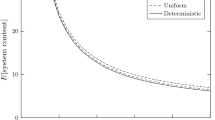Abstract
We consider a system comprised of two connected M/M/•/• type queues, where customers of one queue act as servers for the other queue. One queue, Q 1, operates as a limited-buffer M/M/1/N−1 system. The other queue, Q 2, has an unlimited-buffer and receives service from the customers of Q 1. Such analytic models may represent applications like SETI@home, where idle computers of users are used to process data collected by space radio telescopes. Let L 1 denote the number of customers in Q 1. Then, two models are studied, distinguished by their service discipline in Q 2: In Model 1, Q 2 operates as an unlimited-buffer, single-server M/M/1/∞ queue with Poisson arrival rate λ 2 and dynamically changing service rate μ 2 L 1. In Model 2, Q 2 operates as a multi-server M/M/L 1/∞ queue with varying number of servers, L 1, each serving at a Poisson rate of μ 2.
We analyze both models and derive the Probability Generating Functions of the system’s steady-state probabilities. We then calculate the mean total number of customers present in each queue. Extreme cases are indicated.
Similar content being viewed by others
References
Arazi, A., Ben-Jacob, E., Yechiali, U.: Controlling an oscillating Jackson-type network having state-dependent service rates. Math. Methods Oper. Res. 62, 453–466 (2005)
Avi-Itzhak, B., Mitrani, I.L.: A many-server queue with service interruptions. Oper. Res. 16, 628–638 (1968)
Latouche, G., Ramaswami, V.: Introduction to Matrix Analytic Methods in Stochastic Modeling. ASA, Alexandria (1999)
Levy, Y., Yechiali, U.: An M/M/s Queue with servers’ vacations. Can. J. Oper. Res. Inf. Process. 14, 153–163 (1976)
Mahabhashyam, S.R., Gautam, N.: On queues with Markov modulated service rates. Queueing Syst. 51, 89–113 (2005)
Neuts, M.F.: Matrix-Geometric Solutions in Stochastic Models—An Algorithmic Approach. Johns Hopkins, Baltimore (1981)
Nunez Queija, R., Boxma, O.J.: Analysis of a multi-server queueing model of ABR. J. Appl. Math. Stoch. Anal. 11, 339–354 (1998)
Ozawa, T.: Sojourn time distribution in the queue defined by a general QBD process. Queueing Syst. 53, 203–211 (2006)
Perel, E., Yechiali, U.: 2-queue systems where customers of one queue serve the customers of the other queue. Technical Report, Department of Statistics and Operations Research, Tel Aviv University (2007)
Takine, T.: Single-server queues with Markov-modulated arrivals and service speed. Queueing Syst. 49, 7–22 (2005)
Yechiali, U.: A queueing-type birth-and-death process defined on a continuous Markov chain. Oper. Res. 21, 604–609 (1973)
Author information
Authors and Affiliations
Corresponding author
Rights and permissions
About this article
Cite this article
Perel, E., Yechiali, U. Queues where customers of one queue act as servers of the other queue. Queueing Syst 60, 271–288 (2008). https://doi.org/10.1007/s11134-008-9097-2
Received:
Revised:
Published:
Issue Date:
DOI: https://doi.org/10.1007/s11134-008-9097-2




